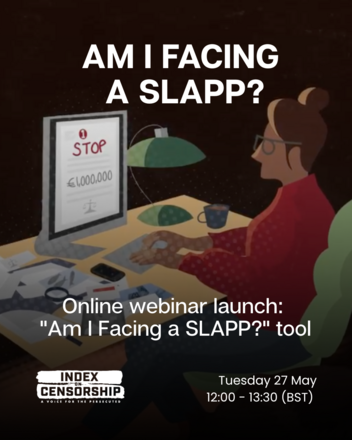
Index on Censorship has launched its interactive tool titled “Am I facing a SLAPP?” on May 27th, which was presented at the webinar “What is a SLAPP? Identifying the tools, tactics and trends”, as Index of Censorship Policy and Campaigns Officer Nik Williams provided an overview of the methodology employed for developing the questionnaire as well as of its functioning through a test run.
Through a set of scored conditioned questions, the interactive questionnaire Index on Censorship set up with the support of the Justice for Journalists Foundation and the Joseph Rowntree Charitable Trust, as well as of a group of leading experts in the field of SLAPPs, aims at offering a first informative tool for targets of vexatious actions or legal threats to help them figuring whether their case might configure as a SLAPP.
Designed as an update of an earlier version of the tool launched in 2020, exclusively focused on press and media actors, the questionnaire was enhanced to include other categories of potential SLAPP targets as well, among which whistleblowers, environmental or climate activists, human right defenders, academics, publishers, survivors of violence or sexual abuse, or users of social media or other online platforms, in order to include a broader range of acts of public participation.
As clarified in the published methodology , the criteria for its development draw from thematic research, legislative developments, analysis and reporting from civil society organisations in relevant fields across Europe.
As the user selects their answers in the questionnaire – fixed response questions related i.e. to the nature of the legal threat, of the act that resulted in it or of the merit of the allegations in substance, to the presence of other forms of harassment, etc. – the tool proceeds to select the following questions in accordance with previous input, establishing a score that allows to determine whether the case in question is either «very unlikely», «unlikely», «likely», or «very likely» to be described as a SLAPP.
The first question is therefore dedicated to the distinction among categories of users that find themselves the target of a potential SLAPP as previously mentioned, which then leads to questions related to the act that resulted in a legal threat, which categories are determined in accordance to the selected category, to subsequent more specific questions; at the end of the questionnaire, it is also possible to opt in to receive a recap of answers sent via email.
Although purely indicative and not conceived as a substitute for actual legal advice, the questionnaire provides a useful informative tool that helps in the identification of potential SLAPP tactics, within the limits due to the high level of heterogeneity in specific threats or behaviours related to SLAPP tactics or to differences in legal cultures or jurisdictions.
Among the experts behind the development of the tool figure Dr. Francesca Farrington – co-convener Anti-SLAPP Research Hub, Aberdeen University, Charlie Holt – Europe Lead, Global Climate Legal Defense, lawyer Vanja Jurić, Prof. Tarlach McGonagle – Programme director of the Information Law master and associate professor at the Institute for Information Law, University of Amsterdam, Rosalin McInnes – Legal Director, BBC Scotland, Jessica Ní Mhianin – Head of Policy and Campaigns at Index on Censorship , Alexander Papachristou – Executive Director at the Cyrus R. Vance Centre for International Justice, Gill Phillips – Editorial Legal Consultant, Prof. Dirk Voorhoof – Professor Emeritus, Freedom of Expression, Human Rights Centre, Ghent University.
Tags: SLAPP Freedom of expression Legal harassmentThe content of this article can be used according to the terms of Creative Commons: Attribution-NonCommercial 4.0 International (CC BY-NC 4.0) . To do so use the the wording "this article was originally published on the Resource Centre on Media Freedom in Europe" including a direct active link to the original article page.